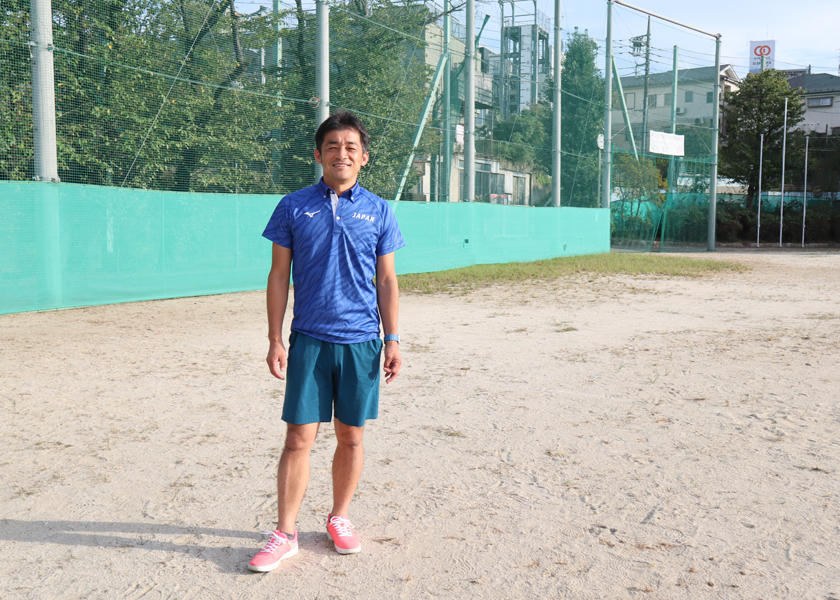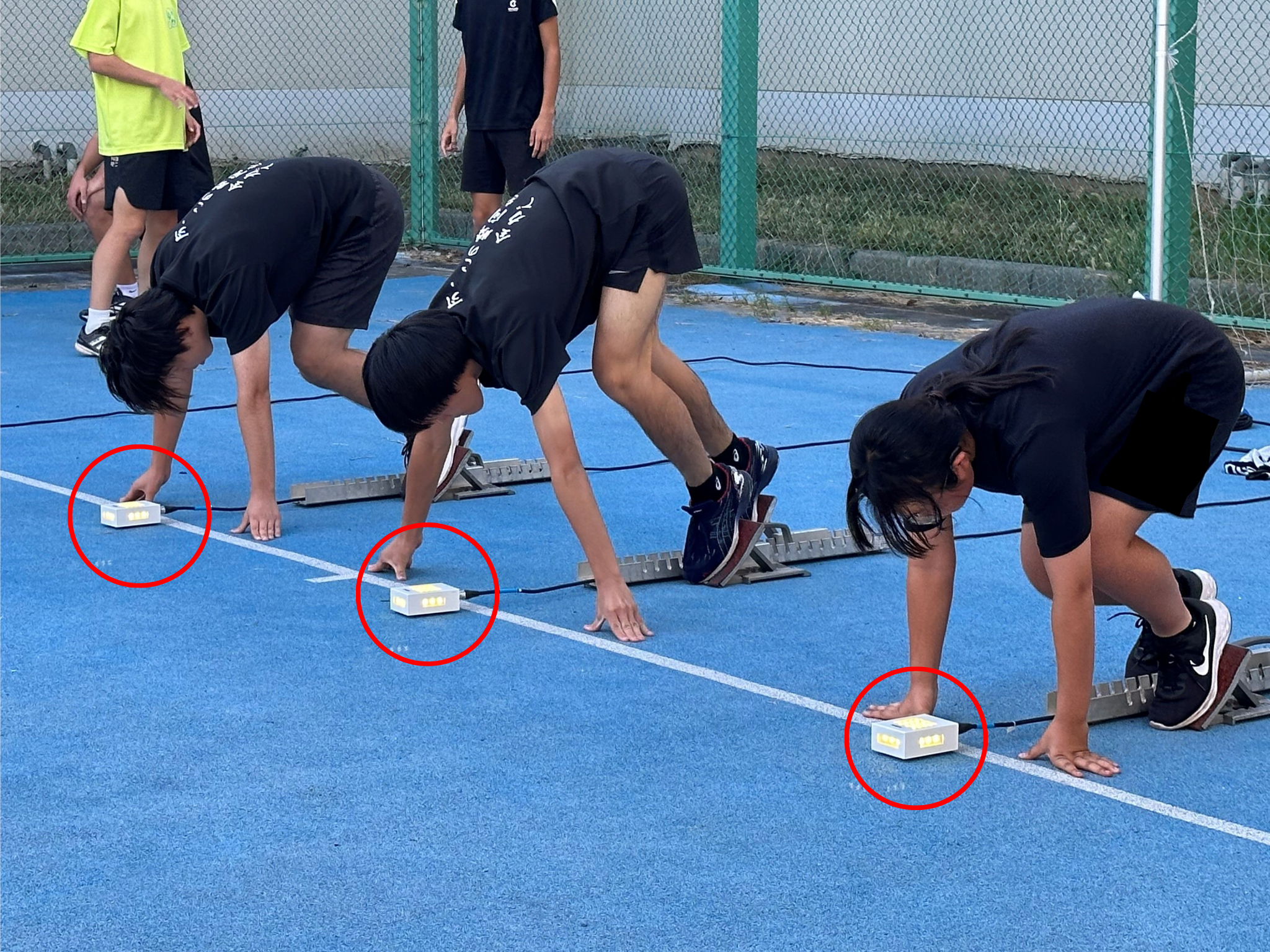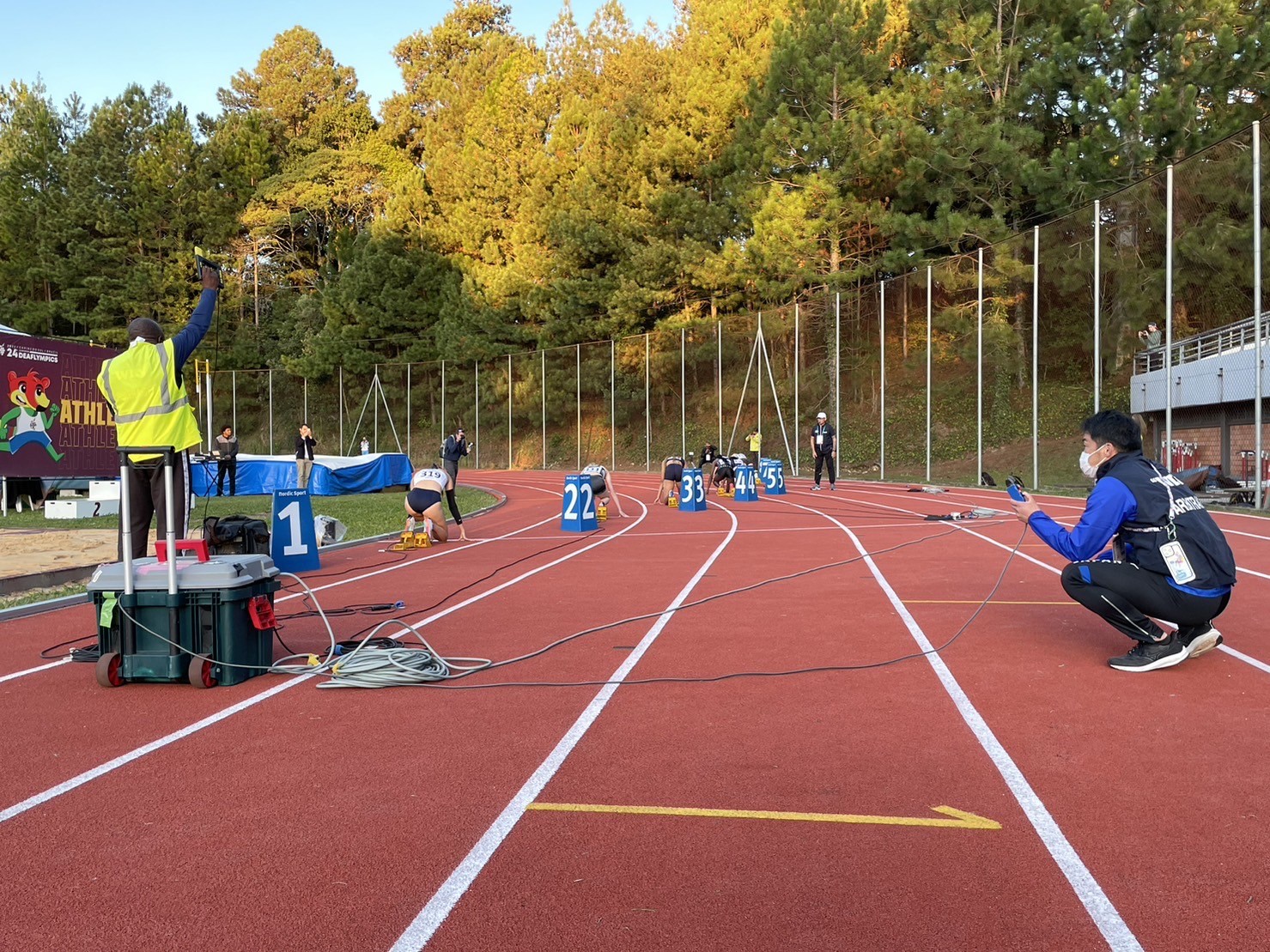Hiroyuki Miura (PLUSVoice, Inc. President and Representative Director)| Realize the “true communication”
2025.07.08
Senior Teacher for High School, Tokyo Metropolitan Chuo School for the Deaf
Deputy Secretary General, Japan Deaf Athletics Association

2023.10.27
Takemi-san, an advisor for the track and field club at a school for the deaf, is also the developer of the “start lamp” used in Deaf track and field events.
We asked him about the origin of his passion and the path he took to develop the device, which took eight years from conception to completion and dissemination, but he never gave up.
目次
Takemi-san: My high school teacher was very kind to me, and seeing that, I thought, “I want to be a teacher”. After I became a teacher, I became involved in athletics, which I had been focusing on since I was a student, as a teacher.
In my ninth year as teacher, after having been assigned to a special needs school, I was transferred to a school for the deaf for the first time. This was the first time I was assigned to teach deaf students.
Takemi-san: As long as you have sign language, there is not much difference regardless of whether you can hear or not. The Chuo School for the Deaf holds workshops for new teachers to help them learn sign language quickly, but when I arrived at the school, there were not many such workshops… So I had a hard time learning sign language, but the students tried to understand me from my gestures. I think there are many children who look down without looking at the teacher’s face when speaking, but they cannot understand what is being said unless they look at the teacher’s face. That is why they stare hard at people’s faces. Students at the school for the deaf have a tremendous ability to insight and observe. I try to speak gently, but since they cannot hear the tone of my voice, they may take it for granted that I am in a bad mood just by looking at my facial expressions. Through these experiences, I learned the importance of facial expressions, such as showing a truly happy smile when laughing, and making an angry expression when angry. Communication is not just about words. The students taught me the importance of looking people in the eye and seeing their faces.
Takemi-san: In track and field, the start of a race relies entirely on sound, for example “On your mark, get set, go!” Therefore, deaf athletes have no choice but to look up and watch the starter’s firing, or start following the movements of the athletes beside them. This of course makes it impossible to start at the same time as the hearing athletes, and it also puts them at a disadvantage in the crouching start, where they have to look down and wait for the start. In athletics, where fractions of a second are at stake, this situation could be considered fatal, but it was the norm when I was assigned to the School for the Deaf in 2014.

One of the students I was teaching participated in a competition, but he still couldn’t react to the starting sound of the start. After the race, the student came to me in tears and said, “No matter how hard I work, I can’t achieve success.”
At that time, I consoled them, but…. I felt the limitations of the current situation and want to change the environment that makes the hard work students feel this way. In the world of sports, the more strictly you judge, the more important sound becomes, so the feeling “I want to create an equal competitive environment for deaf!” grew, and I started to create a start lamp that would turn sound into light.
I had felt the student’s pain before that, but at the time there was a mood like, “We (people with disabilities) need to give it our all!, “We can do it with strong spirit!” And most people said like “If you can’t hear, wear a hearing aid,” or “make an effort to hear as much as possible”. However, as I developed the start lamp, I met with many people and gained more information and knowledge, and I realized that I had been teaching the deaf children wrongly.
For example, when the school chime rings in the middle of a conversation, we can hear only the necessary sounds in our brains and continue the conversation by concentrating on them. But they hear a mixture of different sounds. Hearing aids are not infallible, so they are forced to hear a variety of sounds at the same loudness.
I saw many times deaf students who could not start the race because they could not hear the sounds even with their hearing aids, and we were in a state where it was necessary to think of a way for them to start accurately, or it would be impossible to continue both as a sport and in terms of the students’ aspirations.
*1: A device used to assist the start of track and field events for the deaf. It is linked to the start signal emitted from the start transmitter, and signals the timing of the start to the competitors by the color of the LED light emitted.


*The pistol on the left is the actual starting pistol.
Takemi-san: First, I consulted with Toshiharu Aoyama, the president of the National Deaf Schools Sports Award Organization (*2), which I am a part of, and my teacher at university. The teacher introduced me to NISHI Athletic Goods Co.,Ltd., which manufactures and sells sports equipment, including track and field equipment, and we visited there. So, when I showed the company president at the time the materials I had created about the start lamp, he readily agreed. Afterwards, Saburo Okamoto-san who is a teacher of the Special Needs Education School for the Deaf, University of Tsukuba joined us and we began development. At the time, it was a prototype made by combining off-the-shelf parts, but I was so happy when it was completed that I said, “We’re going to spread this all over the country.” Okamoto-san and I started visiting around the country to spread. That was probably around 2011.
However, when this system first began to be popularized, whenever we showed the Start Lamp, the first reaction at every school was, “We don’t need this, right?” and “The deaf children I know are fine.” A lot of teachers thought the same way I used to think.
※2:An organization that awards physical education awards to students enrolled at schools for the deaf nationwide who have excellent grades in physical education.
Takemi-san: As we used the prototype, we came up with various improvements, but the company would not benefit if we continued to use it as is, so we asked ourselves, “What can we do to commercialize this start lamp?” We decided to take the prototype to the world and promote it. So in 2016, I made a request to the officials of the World Deaf Athletics Championships in Bulgaria, and about three months before the championships, I went there with a representative from the Japan Deaf Athletics Association to show and explain the start lamp to the officials. I persuaded the referees, who were initially opposed to the idea, with great determination, even though we could not speak English, and in the end they agreed to allow us to use the start lamp at the event. After the competition, we heard comments from various people involved, such as, “Thanks to the Start Lamp,” and “Japan’s activities are wonderful.” After returning to Japan, we reported this to the manufacturer, and they approached their upper management with the idea of commercializing the product, and a finished product was realized that incorporated all of our requests. It has come to be used in tournaments all over the country. In recent years, they even decided to include the product in their catalog to further promote sales. It took us about eight years to get to this point (laughs).
Takemi-san: The hardest part was getting people to understand the start lamp. Deaf athlete Takuma Sasaki (*3) and others told me they wanted to use the start lamp, and I took it to the competitions in which they competed. However, some of the people involved were not very happy about it. Some said, “The Deaf people I know could start the race without using this.” I think this means that the Deaf are not well understood. I felt that this is one of the issues that need to be addressed. I want to tell people that everyone’s hearing is different and that not all Deaf people are the same.
Also, the start lamp was originally made for the athletes, but there are deaf people in the audience as well, and I have had them tell me how happy they are that they can now see the start of the race. Then I also discovered that “(the start lamp) can also help people enjoy watching the competition.”
*3: Deaf track and field athlete and Sendai University staff member. He won the gold medal in the men’s 100m at the last Deaflympics in Caxias do Sul 2021. He is a sprinter representing the world of Deaf Athletics.

Takemi-san: It was first adopted in the Deaflympics at the last Games held in Caxias do Sul, Brazil in 2022.
The start lamp was not an official device at first, so records were “Unofficial Record” when it was used. So Aoyama-san took me to the Japan Association of Athletics Federations (JAAF) and I asked, “Can’t you make it an official record when they use the start lamp?” The person who listened to my request checked the IAAF (International Association of Athletics Federations, now WA) rule book. There states that “a light lamp is not an aids,” we decided to change the Japanese rules with them. From there, the start lamp became available, so now they are used in all competitions, including those of the High School Athletic Federation and the All-Japan Businessmen’s Association. The number of municipalities that have purchased start lamps is increasing, and installation has become mandatory at metropolitan schools for the deaf.
However, there are still many tournaments where the equipment is rented out, and some people still don’t know about it. At the first convention where I installed the equipment, I received a lot of comments such as, “What is that? I almost lose heart when I hear people say, “Don’t use that thing. (Laughs) But I have been able to do this because I am a teacher at a school for the deaf. My students’ records have definitely improved. The children themselves say, “My time has improved! I am happy when they are happy. I am happy when the children are happy, and that is the best.
Takemi-san Our activities to promote start lamps include giving lectures on start ramps and Deaf sports at events around the country, arranging for athletes to participate in events, and preparing for international competitions. As the Deaflympics have gained more attention, the number of people participating in events has increased dramatically. I am happy to see so many people who want to volunteer for the Deaflympics.

Takemi-san It is to eliminating the hurdles of the deaf in sports. During the Deaflympics, at the very least, sign language interpreter wipes will be included in TV broadcasts, and restaurants near the venue of the Games will have pointing boards and sign language staff to enable communication. I hope such things can be realized.
I also hope that through the dissemination of the start lamp, it will serve as an opportunity to review and reconsider the field of education for deaf children. I talk with people involved in education, and I think that unless true understanding of the deaf is promoted, it will not spread to the field of sports.
When we go to companies to ask them about start lamps, they sometimes say, “I didn’t know (that such a product existed)”. If we don’t tell them, they don’t know about it. So we, who know about them, have to tell them more about them. I think the Deaflympics is a great place to communicate this. But, I just think it is important for the deaf to take the lead in the action. I often tell my students, “The start lamp is not mine, and it won’t mean anything if you don’t show that you are using it”.
I also want to incorporate entertainment into deaf sports. The start lamps are sound turned into light, but depending on how you look at it, they can also be used as lighting to color the venue. Entertainment can be improved by changing the way we think, and I want to create a world where everyone win-win as a result. We may be able to stage it like a show, and we want to make people enjoy deaf sports with ideas that have never been seen before. That is my biggest goal to make it happen!
Senior Teacher for High School, Tokyo Metropolitan Chuo School for the Deaf
He was a member of the track and field team in high school and college, and after graduating from college, he began his career as a teacher. He was involved in coaching track and field for many years, and at the age of 29, he was transferred to Tachikawa School for the Deaf, where he had previously worked. He became deeply involved in teaching track and field to the Deaf.
He saw students who could not start the short distance track and field race because they could not hear the gun sound, and sensing the lack of consideration for handicaps in Deaf sports, he began developing a start lamp.
Currently, he is the Deputy Secretary General of the National Federation of Athletics Federations for the Deaf and the Japan Deaf Athletics Association, and is involved in the installation of start lamps at international competitions and worldwide promotion of the sport, as well as working toward the Tokyo 2025 Deaflympics.
2025.07.08

目次It all started with the worst MC of his lifeThe reality of being left out of information Issues highlighted […]
2025.07.08
目次It all started with the worst MC of his lifeThe reality of being left out of information Issues highlighted […]
2025.07.08

目次“An charismatic person appears…” Reforms to make athletes’ dreams come trueHakone or the w […]
2025.07.08
目次“An charismatic person appears…” Reforms to make athletes’ dreams come trueHakone or the w […]